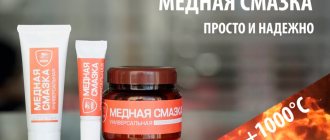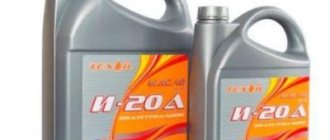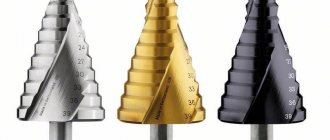Original German autobuffers Power Guard
Mirror-video recorder FUGICAR FC8
Sun blinds Trokot with magnets!!!
Molybdenum lubricants are among the most popular among car enthusiasts today. The lubricant also has many opponents. Supporters focus on the unique qualities of molybdenum lubricants and cite as an example the increased service life of engine parts. Opponents say that lubricant “kills” the engine, also supporting their words with facts.
Composition and properties of molybdenum grease
It is more correct to call this lubricant molybdenum disulfide grease (DMI, IV). It is produced in the form of gray, black or slightly blue sprays, liquids, powders and thick plastic substances. The main active component is an inorganic compound of molybdenum with sulfur. The chemical formula of the substance molybdenite is written MoS2. Each molecule contains one molybdenum atom and two sulfur atoms.
Once on the metal surface, molybdenum lubricant forms a layer about 5 microns thick. One sulfur atom is firmly attached to the metal, and the second is located outside, with molybdenum between them. As a result of this interaction, a three-layer nano-coating is formed. The first layer is sulfur atoms, securely adhered to the metal part. The second layer is molybdenum. On the outside there is again a layer of sulfur atoms.
If two metal parts are coated molybdenum disulfide grease, only the outer layers are in contact. The adhesive force between the sulfur atoms that come into contact is very small, so friction is minimal. On the contrary, sulfur attaches very strongly to steel and molybdenum, creating a durable film that is difficult to wash off. Thanks to this feature, the lubricating layer has a high degree of wear resistance.
This chemical composition and structure determine the following parameters and characteristics of molybdenum grease:
- specific strength;
- resistance to corrosion, high temperature and mechanical damage;
- chemical stability;
- anti-seize properties.
Molybdenum-based greases perform well under shock loads, eliminating the risk of seizing moving parts.
Brief description of MoS2
The production of natural molybdenum disulfide occurs during the processing of molybdenum luster formed during the extraction of copper ore.
MoS2 is characterized by the following features:
- . the presence of a steel gray tint;
- . the density indicator of the substance is 4,800 kg/m3;
- . Friction K decreases significantly with increasing specific load and reaches 0.02;
- . In dry form it is a crystalline powder, where each crystal has a needle-type structure.
Molybdenum disulfide is also successfully used as an additional additive in the composition of technical lubricants, both plastic and liquid categories.
For what problems is it better to buy molybdenum grease?
Modern lubricants are developed to solve a limited range of problems. Narrow specialization allows you to achieve high performance. Molybdenum disulfide greases are a prime example of this approach.
The main range of tasks where they are used:
- running-in of components in new and repaired units;
- extending the service life of parts that operate under difficult conditions;
- general protection of mechanisms from such phenomena as metal aging.
The most widespread use of molybdenum grease is in cars, agricultural and construction equipment, industrial equipment and machine tools. These materials are also used in aircraft and watercraft.
In more detail, this lubricant does an excellent job of protecting locks, hinges, and hinges. The greatest effect is obtained if molybdenum disulfide grease is used to treat components operating under heavy dynamic loads:
- bearings (including wheel bearings);
- CV joints;
- ball and U-shaped joints;
- gearboxes;
- worm gears;
- high pressure valves.
Why aren't pistons, crankshafts and other engine parts on this list? It would seem that this is where molybdenum grease belongs: high temperatures and extreme mechanical loads. It is not that simple.
Plastic materials based on molybdenum
The characteristics of molybdenum work best when combined with other components. For example, lithium-molybdenum grease has enhanced protective properties and can additionally protect mechanism elements from shock loads. The use of these types of lubricants significantly increases the strength of the surfaces of parts.
They are widely used in the processing of bearings, gear mechanisms, and to provide lubrication for various types of gearboxes.
Is it worth buying molybdenum engine lubricant?
The protective properties of molybdenum have been known since the 18th century. Molybdenum grease first used in practical in 1935. The quality of the product was, of course, much lower than what modern manufacturers offer. The lubricant contained abrasive quartzite particles, which caused mechanical wear of the parts. In the early 40s of the last century, engineers managed to solve this problem.
Progress does not stand still. Today, using molybdenum lubricant in engines can be a problem. To understand where the legs of this problem come from, we will have to return once again to the composition of the lubricant.
Molybdenum disulfide lubricants are not a chemical solution, but a mixture. That is, the liquid component contains a suspension of disulfide particles. During engine operation, this solid fraction ends up where its presence leads to problems. For example, on piston rings and grooves.
Under the influence of extremely high temperatures, the solid fraction causes coking of the piston rings. They simply “lie down”. As a result of this violation, hot gases from the combustion chamber break into the crankcase and oxidize the engine oil. This speeds up the coke deposition process.
| For a car engine, it is better to use high-quality motor oil from trusted manufacturers. |
Another problem with using molybdenum grease in modern engines is related to detergent additives. Alkaline solutions and calcium react with molybdenum before it has time to form a protective film on the surface of the parts. All positive effects disappear. But that is not all.
As a result of such a reaction, molecules that are quite large in size are formed. They settle on the oil filter, accelerating its contamination. That is, by adding a molybdenum-based additive to engine oil, you start a chain reaction:
- detergent additives are consumed by reaction with molybdenum lubricant;
- the products of these reactions clog the oil filter;
- General contamination of the engine lubrication system accelerates.
It should also be taken into account that molybdenum additives actively interact with oxygen and water. If these components enter the lubricant, the disulfide breaks down to form sulfuric acid and particulate molybdenum oxide particles. Acid corrodes steel, and the abrasive oxide fraction further increases wear.
For this reason, even if the car manufacturer does not prohibit the use of molybdenum grease in a car, negative consequences are possible. It is enough to drive with a faulty lubrication system, which receives air or moisture. We think all car enthusiasts can imagine how much it costs to repair an engine.
The need for use in automatic mechanisms
The leading position in the production and supply of such additives, as several years ago, belongs to the one already mentioned above. One of the company’s popular products is, for example, LIQUI MOLY 3520, which is a CV joint lubricant with molybdenum disulfide, sold under the brand name LM 47 Langzeitfett + MoS2.
It has long been studied and proven that such a technical lubricant, which contains molybdenum disulfide in sufficient quantities, is highly effective when processing bearing mechanisms and CV joints.
In modern methods of maintenance of mechanisms and automated systems, a group of universal-purpose lithium greases, in which dispersed molybdenum disulfide is contained in an amount equal to 3%, and the particle size is defined in the range from 0.65 to 0.75 µm, has become widespread.
Despite their excellent resistance to water and dampness, prevention and protection from oxidative phenomena, corrosive formations, and wear protection, lubricants with molybdenum disulfide are quite affordable. The cost, for example, of the same Liqui Moly lubricant will range from 250 to 550 rubles per 250 ml tube, depending on the specific brand and purpose of the additive.
Molybdenum Throttle Lubricant
One of the parts for which the use of molybdenum lubricant brings only advantages is the throttle valve. This part regulates the degree of enrichment of the fuel mixture. As a result of operation, deposits of fuel combustion products accumulate on its surface, and it suffers mechanical damage.
Molybdenum lubricant for the throttle valve reduces frictional effects and increases tightness. The use of this lubricant ensures smooth operation of the mechanism. In addition, it provides protection against corrosion and a low probability of damper jamming.
Application of molybdenum disulfide grease for wheel bearing
Experts are unanimous in their opinion that the decision to buy molybdenum grease for servicing a wheel bearing is an excellent, cost-effective option.
This lubricant has a number of properties that make it ideal for this application:
- resource - about 100 thousand km, which corresponds to a similar bearing parameter. It is enough to apply lubricant once for the entire period of operation;
- The lubricant provides excellent protection against corrosion. The film on the surface of the parts prevents contact of the metal with oxidizing agents;
- excellent indicators of mechanical strength and reduction of friction forces.
You just need to make sure that the wheel bearing housing is sealed. If moisture gets into the molybdenum grease , it will have to be replaced. We have already discussed above what the risk of water getting into this lubricant is.
| You can read more about how to use reconditioning grease in wheel bearings in our article: “The hub bearing is humming” “...When operating a car, it is important to monitor its technical condition. There should be no extraneous sounds when moving. For example, if a wheel bearing is humming, this is a signal that repairs are needed, or rather, replacement. The standard service life of a part is about 100 thousand kilometers, but in Europe. Our motorists need to make allowances for road conditions. It is clear that in the direction of reducing the resource..." Read the article... |
A little history
The protective properties of molybdenum disulfide (MoS2) have been known for a long time. Even during World War II, the Germans actively used this additive in oil on their equipment. This lubricant has especially caught on on tanks.
In case of damage to the tank engine and oil leakage, the power unit was able to continue operating for some time thanks to the molybdenum protective layer. This often made it possible to leave the battle and get to the repair site on your own.
Also, the American military used oil with molybdenum in various units and components. For example, similar lubricants were used for helicopters during the Vietnam War. If an emergency oil leak occurred, the damaged unit continued to operate without oil, allowing the pilot to remain in the air and gain time to land the machine.
Which molybdenum grease is best to buy?
We will not discover anything new if we say that products from the middle price category or slightly more expensive have optimal parameters. On the Russian market, stores offer imported products at high prices and more affordable domestic products.
Suprotek Universal-M grease for CV joints and bearings
To increase the service life and recover from wear of rolling bearings, CV joints and other components.
more reviews
In our opinion, the molybdenum lubricants “Universal-M” and “Universal PRO” from Suprotec from St. Petersburg have the optimal price-to-quality ratio. Independent testing of these restorative tribotechnical consistency compositions has shown that they are superior to foreign analogues in many performance parameters.
Characteristics
Molybdenum-based grease has a number of advantages over other types.
The main advantages include stable operation under conditions of high extreme loads. It also does not lose its qualities when temperatures drop or rise critically, has anti-corrosion properties, and helps prevent wear and mechanical damage. Regardless of aggressive conditions, it provides the mechanism with a long lubrication torque. Molybdenum lubricants, unlike graphite materials, have significantly higher
anti-friction properties,
have greater restorative ability. They can be produced in the form of aerosols, greases and oils. They are used in various engineering industries. Namely in the automotive industry, machine tool industry, to increase the service life of complex industrial mechanisms.











